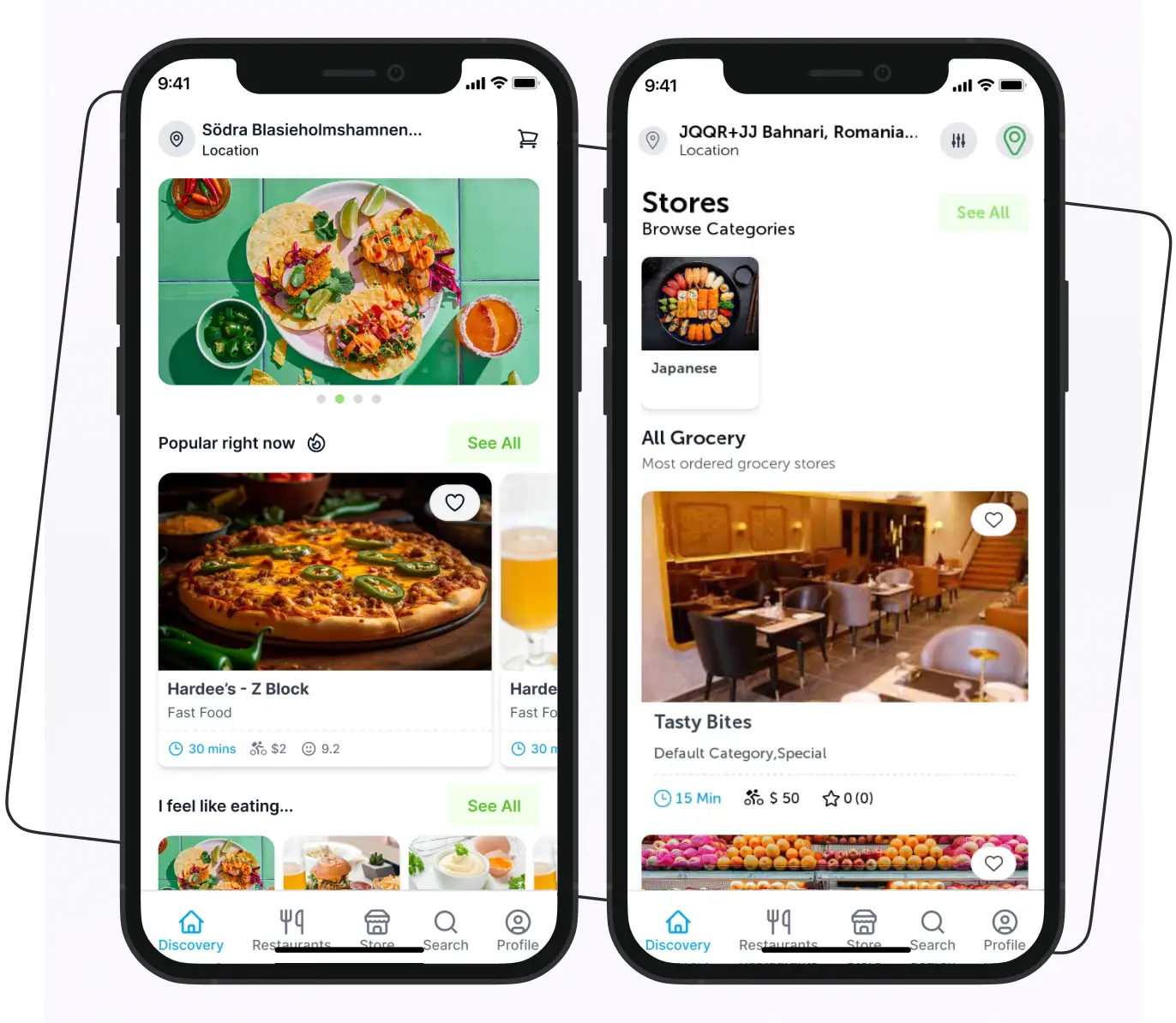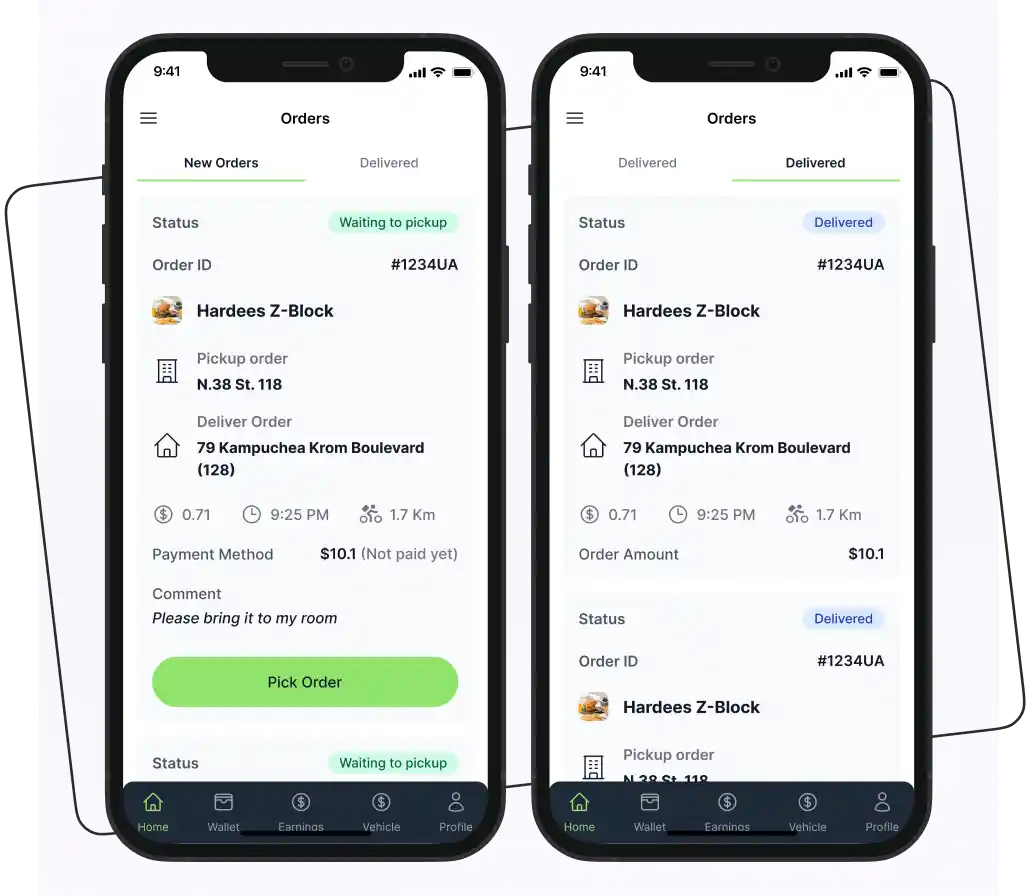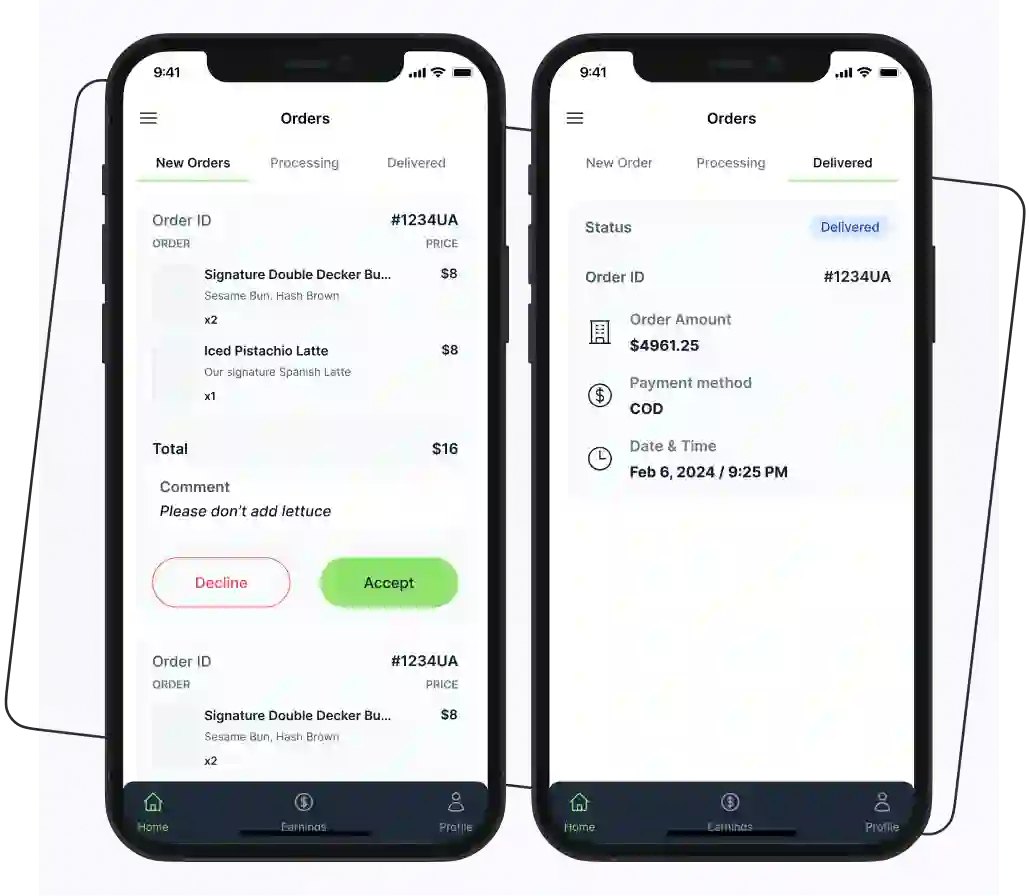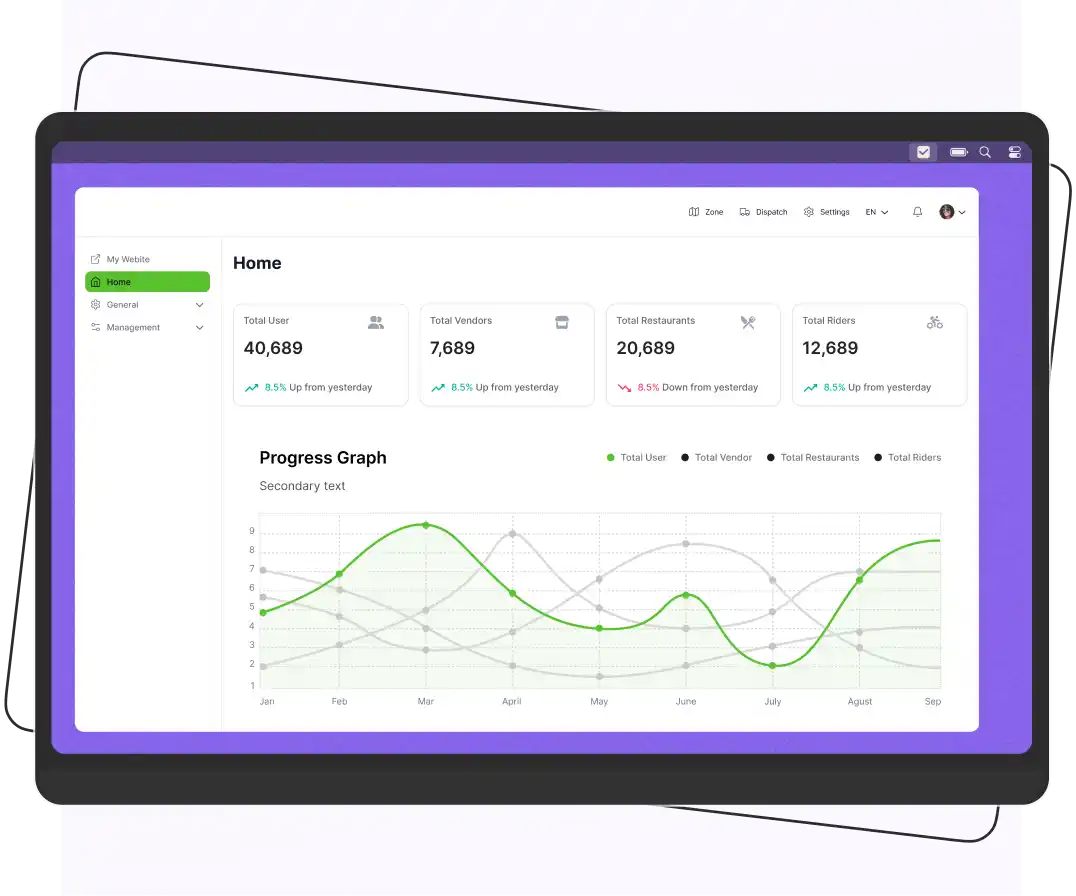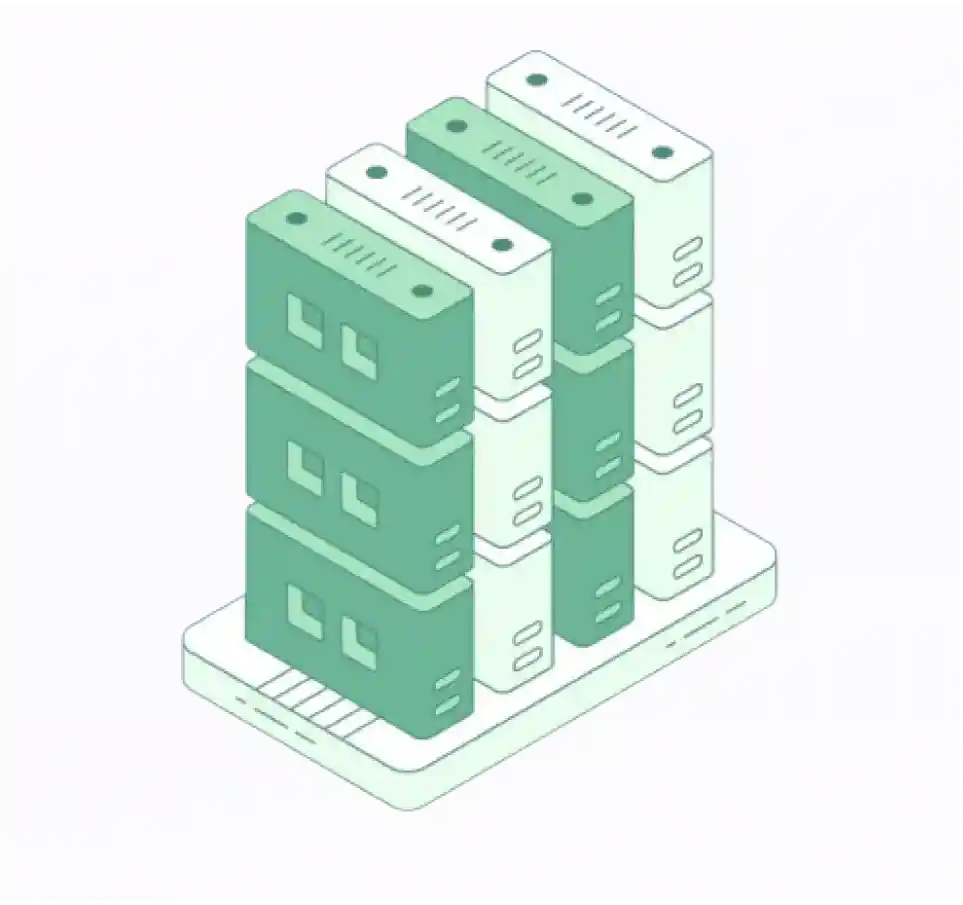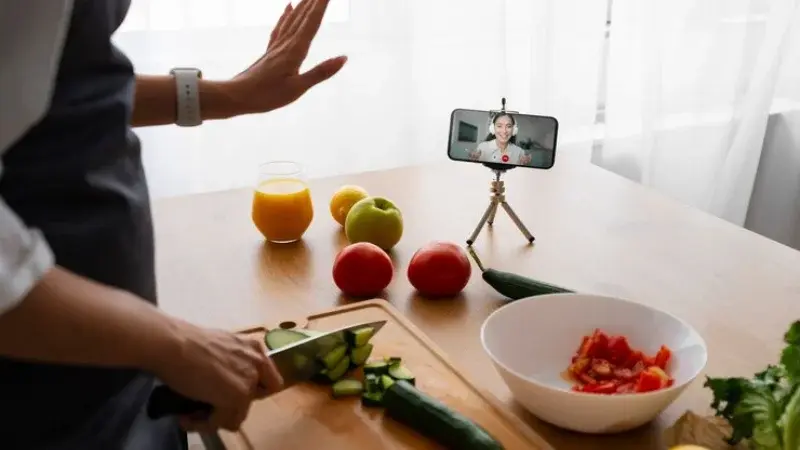
Key Takeaways
- Low-Cost Startup: No storefront needed, just a kitchen and online orders.
- Growing Market: Expected to hit $155.54 billion by 2030 with a 13.2% CAGR.
- Benefits: Lower costs, flexible menus, and wider reach via delivery apps.
- Challenges: High competition, reliance on delivery services, and brand visibility.
- Steps to Start: Plan concept, set up a kitchen, list on delivery apps, and market effectively.
- Success Examples: MrBeast Burger, The Burger Den, Wing Squad.
Want to run a restaurant without paying rent or hiring a large team? Virtual restaurants let you start right from your kitchen, and entrepreneurs are already making six-figure incomes from delivery-only brands.
Whether you’re a home chef looking to monetize your culinary skills or an entrepreneur wanting to enter the food industry, this innovative model offers flexibility, lower costs, and limitless growth potential.
In fact, a 2022 survey by Grubhub and Technomic found that 41% of independent restaurants have adopted virtual restaurant concepts.
With online food delivery growing, now is the perfect time to start. This blog will walk you through the essential steps to launch your virtual restaurant, tips to attract customers, and scale your business successfully.
What is a Virtual Restaurant?
A virtual restaurant, also known as a virtual kitchen, is a digital food business that caters to customers ordering online for takeout or delivery. This innovative model allows existing restaurants to launch additional brands using their current kitchen and staff, presenting new avenues for business expansion.
The rise of virtual restaurants has been remarkable, since the pandemic, when dining in was not an option.
The global virtual restaurant market size is predicted to reach USD 155.54 billion by 2030 with a CAGR of 13.20%.
According to Statista, virtual kitchens can reduce labor costs by up to 25%, and cut rent expenses by 20-40%.
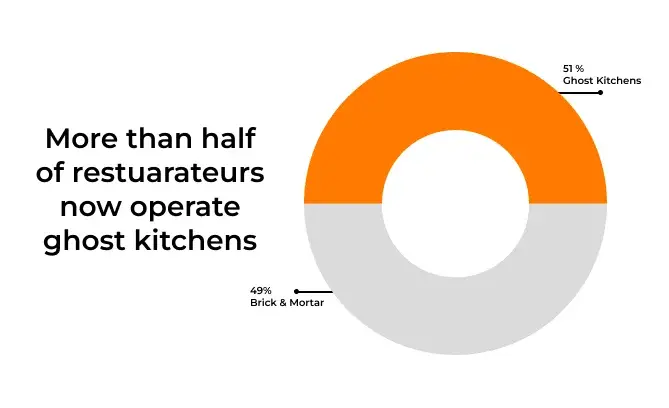
The main purpose of starting a virtual restaurant is to:
- Reach new customers and boost sales without increasing operational costs.
- Try out new menu items without risking your main restaurant brand.
- Help you increase your visibility on third-party delivery platforms.
- Avoid the expenses of a new storefront or commercial kitchen by using your existing resources.
- Shift your attention from equipment layout to enhancing customer service.
- Help you take advantage of off-hours, like early morning or late nights.
Virtual Restaurant Models
Below are the virtual restaurant models.
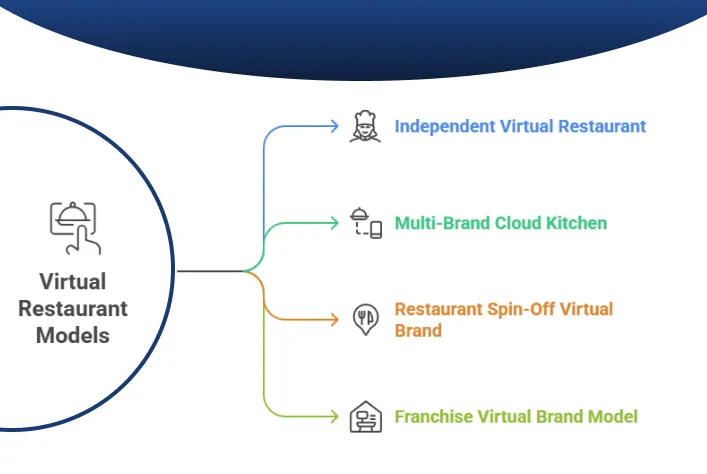
Independent Virtual Restaurant
A restaurant brand that exists only online with no physical storefront.
- How it Works: Operates from a rented kitchen or home base, listing menus exclusively on delivery apps.
- Example: A local brand offering “Healthy Bowls” on Uber Eats but without a dine-in spot.
- Best For: Startups testing new food concepts with minimal investment.
Multi-Brand Cloud Kitchen
A single kitchen that houses multiple virtual brands owned by one operator.
- How it Works: One company creates several niche menus (e.g., burgers, sushi, desserts) under different brand names, all prepared in the same kitchen.
- Example: A kitchen selling “HotWings Express,” “PastaBox,” and “Vegan Bites” from one location.
- Best For: Increasing delivery volume by targeting multiple cuisines or customer segments.
Restaurant Spin-Off Virtual Brand
A traditional restaurant launches a virtual-only sub-brand from its existing kitchen.
- How it Works: Uses the same staff and equipment to serve a new online-only menu.
- Example: A pizza shop offering a separate “Wings & Fries” brand on delivery apps.
- Best For: Established restaurants looking for new revenue streams without additional real estate.
Franchise Virtual Brand Model
Entrepreneurs license existing virtual restaurant brands (created by larger companies) and operate them locally.
- How it Works: The central brand provides recipes, training, marketing materials, and delivery integration.
- Example: Reef Technology or Virtual Dining Concepts (like MrBeast Burger).
- Best For: Franchisees wanting to enter the food delivery industry without creating a brand from scratch.
How do Virtual Restaurants Work?
Here are the steps to show the workings of a virtual restaurant.

Order Placement
- Customers place orders through apps or websites. They may choose from various virtual restaurant brands operating from the same kitchen.
Food Preparation
- Once an order is received, the kitchen staff prepares the meal.
Delivery
- After food preparation, the meal is packaged and handed off to delivery riders from third-party services or in-house couriers.
Feedback and Adaptation
- Operators gather customer feedback and sales data to adapt menus and marketing strategies quickly.
Supercharge your deliveries with Enatega.
Launch NowPros and Cons of Opening a Virtual Restaurant
Here are the pros and cons of opening a virtual restaurant.
| Pros | Cons |
| Lower startup costs: Minimal investment in real estate and decor, reducing initial financial burden. | Higher competition: Many virtual restaurants compete for the same delivery market, making it crowded. |
| Flexibility in menu offerings: Ability to quickly change menu items based on trends or customer feedback without major costs. | Dependence on delivery services: Reliance on third-party delivery services can affect service quality and reliability. |
| No need for a physical location: Eliminates rent and utility costs associated with a traditional restaurant setup. | Limited brand visibility: Harder to establish a recognizable brand without a physical presence. |
| Ability to target specific markets: Focus on niche markets or specific dietary preferences to attract dedicated customer bases. | Marketing challenges: Requires digital marketing expertise to effectively reach and engage potential customers. |
| Reduced overhead expenses: Savings on labor and operational costs compared to traditional restaurants. | Potential quality control issues: Maintaining food quality during delivery can be challenging and impact customer satisfaction. |
| Opportunity for innovation: Freedom to experiment with unique concepts and menu items that might not work in a traditional setting. | Customer trust may take time to build: New brands may struggle to gain trust without a physical presence or established reputation. |
| Easier to adapt to trends: Quick adjustments to the menu and operations in response to changing consumer preferences. | Limited customer interaction: Less face-to-face interaction can hinder relationship-building with customers. |
How to Start a Virtual Restaurant from Home?
The virtual restaurant is the most unique restaurant ideas that allow you to cook food remotely and deliver it directly to your customers’ doorsteps through third-party delivery services.
Below are some steps to help you start a virtual restaurant from home.
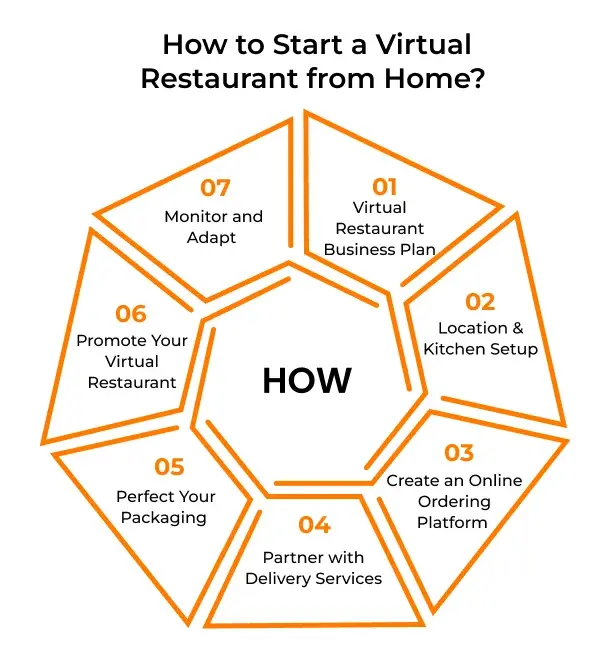
1. Virtual Restaurant Business Plan
Before launching a virtual restaurant platform, it’s vital to have a well-defined business plan. A good restaurant business plan not only lays the groundwork for starting your restaurant but also supports ongoing operations and future growth.
In the business plan of a virtual kitchen, you will clearly define these things:
- Identify other food businesses and investigate what they are doing in your area.
- Determine the target audience for your new offerings.
- Determine the type of food you’ll prepare to serve your customers.
- Decide on the vision of your business, and it should reflect the demands of your target market.
- Defining your restaurant’s brand or identity.
- Examine the cost that will need to be invested.
- Create a plan for how to reach your customers.
To avoid any mistakes related to finances and staff, it is essential to create a structured plan and follow it properly.
2. Location and Kitchen Setup
In this step, choose the location for your virtual kitchen. This could be an in-house kitchen, a food truck in your backyard, or any space that allows you to prepare and cook food conveniently. Ensure you designate a specific area for organizing and packaging your delivery orders.
Moreover, it’s important to follow the local health department regulations and maintain a clean and safe cooking environment.
3. Create an Online Ordering Platform
Establish a professional website where customers can place orders and contact you. Your online platform should be user-friendly and showcase menu items, pricing, and more.
Research indicates that 35% of customers discover new restaurants through their websites, making this step important for your restaurant’s visibility and success.
Make your virtual restaurant platform branding attractive and eye-catching. Build an online presence that matches your vision and offers a user-friendly experience to your customers.
4. Partner with Delivery Services
Consider collaborating with third-party delivery services like Grubhub, UberEats, and DoorDash to reach a broader audience. This will help better manage the delivery process and ensure your food reaches customers quickly.
5. Perfect Your Packaging
Think about the best way to package your to-go items so they stay delicious and visually appealing, just like they would when served fresh. Using eco-friendly packaging not only benefits the planet but also shows conscious consumers that you care about making thoughtful choices.
6. Promote Your Virtual Restaurant
Use social media, online advertising, and local marketing strategies to promote your restaurant. Engage with your community and encourage word-of-mouth referrals.
Additionally, hire a copywriter to promote your brand on different digital channels by writing blogs and articles.
7. Monitor and Adapt
Once you launch, continuously monitor your business performance. Gather customer feedback, track sales, and be ready to make adjustments to your menu or operations as needed.
Virtual Restaurant Vs. Ghost Kitchen
What is a ghost kitchen vs a virtual restaurant?
The table below shows the differences between a virtual restaurant and a ghost kitchen.
| Feature | Virtual Restaurant | Ghost Kitchen |
| Business Model | Focused on direct-to-consumer sales through delivery apps. | Can serve multiple brands, often under one roof, maximizing kitchen resources. |
| Branding | Unique branding and identity for each virtual restaurant. | May have multiple brands sharing the same kitchen space. |
| Location | Can operate from any commercial kitchen space. | Located in areas with lower rent, such as industrial zones. |
| Customer Experience | Focused on branding and customer engagement through digital platforms. | Less emphasis on branding; customer interaction is minimal. |
| Delivery Focus | Heavily reliant on third-party delivery services. | Also reliant on delivery services, often optimizing routes for efficiency. |
Top Virtual Restaurant Brands
Below is a list of virtual restaurants.
Nextbite
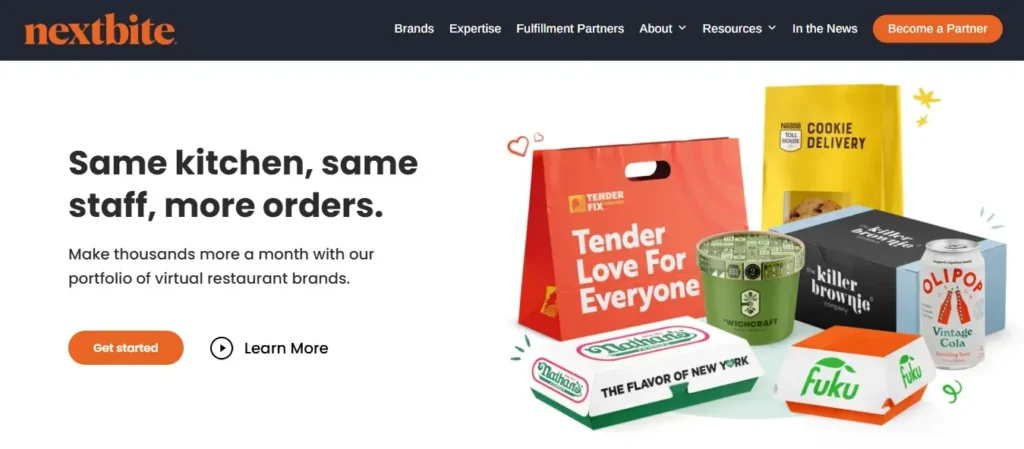
Nextbite is a company that specializes in virtual restaurants and food delivery. They partner with restaurants to create delivery-only brands, allowing businesses to expand their offerings without the need for additional physical locations.
This model enables restaurants to reach more customers through online platforms while minimizing overhead costs.
| Pros | Cons |
| Established partnerships with existing restaurants for operational efficiency. | Brand recognition may be lower compared to traditional restaurants. |
| Diverse menu options | Quality control can vary since food is prepared in partner kitchens. |
The Burger Den

The Burger Den is a virtual restaurant brand created by Denny’s. They focus on delivering a variety of burgers and related menu items. It operates exclusively through online ordering and delivery platforms, allowing customers to enjoy gourmet-style burgers from the comfort of their homes.
| Pros | Cons |
| Focus on gourmet burger options that appeal to a wide audience. | Limited menu variety beyond burgers. |
| Competition with local burger joints can be intense. |
MrBeast Burger
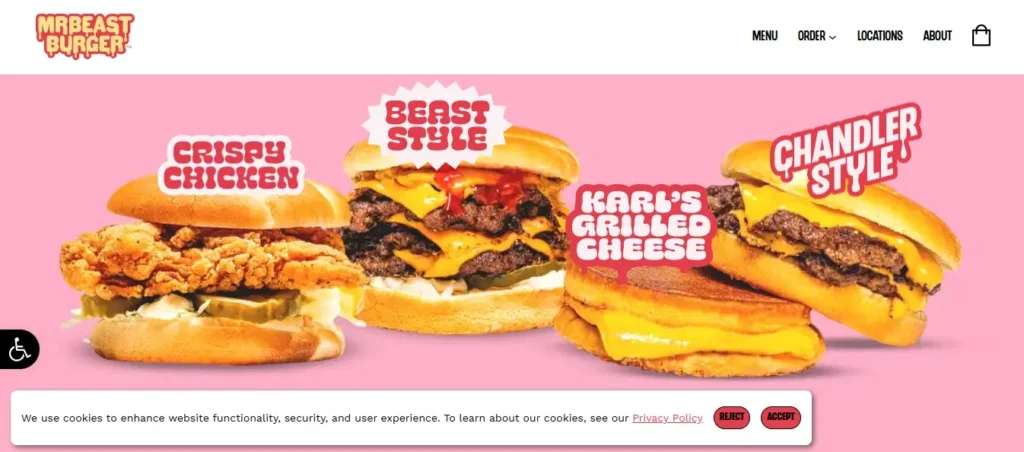
MrBeast Burger is one of the great virtual restaurant examples. This brand was created by YouTuber MrBeast (Jimmy Donaldson). Launched in December 2020, it operates through a ghost kitchen model, and don’t have traditional dine-in locations. Instead, the burgers are prepared in existing restaurants that partner with the brand.
Smashed burgers, crispy chicken sandwiches, outrageous grilled cheese, and seasoned crinkle fries are their main specialties.
| Pros | Cons |
| High brand visibility due to MrBeast’s massive online following. | Variability in food quality depends on partner locations. |
| Unique marketing strategies that drive customer interest. |
Wing Squad
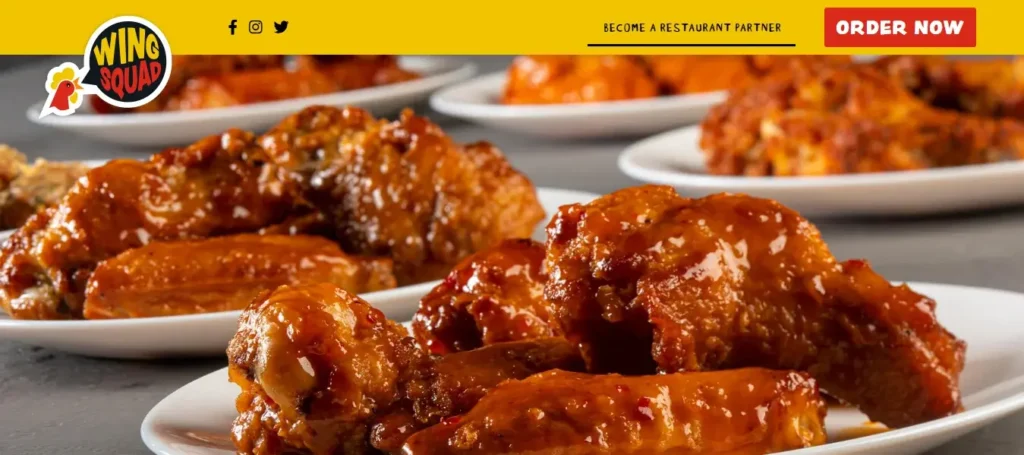
Wing Squad is another virtual restaurant brand that focuses on delivering a variety of chicken wings and related items. Like other virtual brands, it operates through a delivery-only model, partnering with existing restaurants to prepare and serve its menu items.
| Pros | Cons |
| Offers a wide range of flavors and sauces to attract diverse customers. | Limited appeal outside of wing lovers. |
| Seasonal demand fluctuations can affect sales. |
Just like MrBeast Burger scaled nationwide through ghost kitchens, you too can replicate this model at a smaller scale right from your home.
Franklin Junction
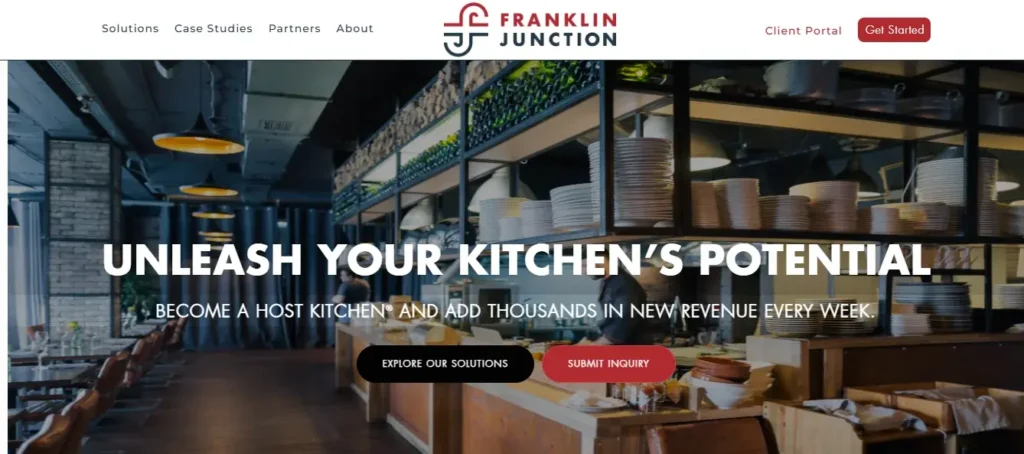
Franklin Junction is a company that specializes in helping restaurants and food brands expand their reach through virtual kitchens and delivery-only concepts. They focus on creating partnerships with existing restaurants, allowing them to launch new virtual brands without the need for additional physical locations.
| Pros | Cons |
| Focuses on connecting restaurants with virtual brand partnerships. | May require restaurants to adapt to new menu items |
| Flexibility for restaurants to offer new concepts without large overhead |
Challenges and Solutions of Running a Virtual Kitchen
Here are some challenges with their solutions that you can face in running a virtual kitchen.
Challenge: High Competition and Market Saturation
With the rise of food delivery apps, virtual kitchens are growing, but so is competition. Many brands compete for the same customer base, offering similar cuisines and pricing.
Solutions
- Develop a unique menu niche (e.g., keto, organic, regional comfort food).
- Focus on branding and packaging to stand out visually on delivery apps.
- Optimize menu descriptions and photos for better click-through rates.
- Use customer feedback to refine offerings based on real demand data.
Challenge: Dependence on Delivery Platforms
Relying heavily on aggregators like Uber Eats, DoorDash, or Foodpanda can lead to high commission fees (15–30%) and limited control over customer relationships.
Solutions
- Build a direct online ordering website or app to reduce platform fees.
- Offer exclusive discounts for direct orders to encourage repeat customers.
- Collect customer data (emails, preferences) via loyalty programs or SMS marketing.
Challenge: Maintaining Food Quality During Delivery
Without dine-in service, presentation and temperature control depend on delivery time and packaging. Poor experiences can harm reviews and repeat orders.
Solutions
- Invest in high-quality packaging that retains temperature and freshness.
- Simplify menus to items that travel well.
- Use delivery time tracking and real-time order monitoring to ensure consistency.
- Train kitchen staff to package quickly and efficiently.
Challenge: Limited Brand Visibility
Without a storefront, it’s harder to build local brand recognition. Many customers may not even realize your kitchen exists.
Solutions
- Create a strong digital presence through social media, Google Business Profile, and local SEO.
- Collaborate with influencers or food bloggers for reviews and exposure.
- Encourage customers to share photos or reviews on social platforms.
- Use performance ads targeting local delivery zones to increase visibility.
Challenge: Managing Multiple Brands or Menus
Operators with multiple virtual brands may struggle with order confusion, kitchen workflow, and inventory overlap.
Solutions
- Use a centralized restaurant management system (POS + delivery aggregator integrations).
- Optimize kitchen layouts for faster cross-brand preparation.
- Train staff in efficient multi-brand order fulfillment.
Challenge: Logistics and Delivery Delays
Unreliable delivery times or third-party driver shortages can lead to cold food and poor reviews.
Solutions
- Partner with multiple delivery fleets to balance availability.
- Use AI-based delivery route optimization if managing your own drivers.
- Offer scheduled delivery options to set customer expectations.
- Track delivery performance and gather customer feedback regularly.
Tips for Starting a Virtual Restaurant
Below are some tips to help you start a virtual restaurant.
- Build an unbeatable menu and offer something unique that no one else does.
- Partner with suitable suppliers to provide you with consistent ingredient delivery services.
- Pick a trusted partner for delivery services. Do some research and then select it.
- Carefully choose the location for your virtual restaurant.
- Use different marketing channels to promote your business and attract a large number of customers.
FAQs
1. How to start a virtual restaurant on DoorDash?
Below are some steps to help you start a virtual restaurant on DoorDash.
- Create a unique brand and menu.
- Register as a partner on their platform, and ensure you have a reliable kitchen space for food preparation.
- Promote your restaurant through social media and DoorDash’s marketing tools to attract customers.
2. What is the failure rate of ghost kitchens?
The failure rate of ghost kitchens varies, but estimates suggest that about 60% of them may close within the first year. Factors contributing to this include high competition, poor location choices, and inadequate marketing strategies.
3. What is the profit margin of Cloud Kitchen?
The profit margin for cloud kitchens ranges from 10% to 30%. Factors influencing this margin include operational efficiency, food costs, pricing strategy, and demand in the delivery market.
4. Are virtual restaurants legal?
Yes, virtual restaurants are legal. However, they must comply with local health regulations, food safety standards, and business licensing requirements in their operating region. They operate as delivery-only or takeout establishments, often using existing kitchen facilities.
5. Are virtual kitchens safe?
Yes, virtual kitchens are safe if they follow proper food safety regulations, maintain hygiene standards, and comply with local health department guidelines.
6. Are virtual restaurants profitable?
Yes, virtual restaurants can be highly profitable due to low overhead costs and flexibility in operations. However, profitability depends on factors like efficient marketing, menu quality, and managing delivery platform fees.
7. How much does it cost to start an online food business?
The cost to start an online food business can range from under $1,000 for a small, home-based operation to over $10,000 for a larger online store with significant inventory. This cost is heavily influenced by several factors, like the business model, inventory, website development, and marketing.
Supercharge your deliveries with Enatega.
Launch NowConclusion
Experts predict that virtual restaurants will continue to grow in popularity in the food industry. They are the best choice for those who have a strong passion for entering the food industry with minimal financial cost.
So, if you want to start a virtual restaurant and need to create an app for it, consider partnering with a food delivery app development company like Enatega. We have experts who build tailored solutions like a Foodpanda clone, Grubhub clone, etc, that meet your business needs.
Ready to start your virtual restaurant? Book a free demo with Enatega today and launch your online food business in no time!












 IOS
IOS Android
Android Web
Web